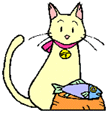Canned Food Diets
By Garry White
Before we proceed to the plusses and minuses of a canned food diet, let’s look at some of the facts surrounding pet foods in general:
- The claim “Complete and Balanced” on the label means the cat food has been tested and meets all the nutritional requirements as a sole source of nutrition…which means a cat can exist on this food alone. These guidelines apply to canned or dry foods.
- These tests and guidelines are established by AAFCO (Association of American Feed Control Officials) and are enforced by the FDA, as well as the U.S. Department of Agriculture.
- Pet foods must comply with guidelines that are much more strict than with human foods. Chocolate chip cookies, for example, may legally have a few -or many-chocolate chips. But a cat food that claims to be “Chicken Cat Food” must contain at least 95% chicken. One claiming to be “Chicken Dinner” must contain at least 25% chicken.
- Ingredients on a cat-food label are in descending order, in terms of weight. For actual percentages of each ingredient, most manufacturers will supply a Nutrient Reference Chart.
Canned Food Diets
Many people are considering a canned-food only diet for their kitty, and there is logic to support this: Canned foods contain more water (70-75%), which helps to maintain hydration simply by eating. Canned foods are a “whole food”; Kitty needs no other nutrients. Canned foods offer a wider range of nutritional composition than do dry foods, as well as better management of protein and other nutrients. Canned foods are fresh when opened, therefore are often more appealing to a cat’s sense of smell, which is crucial: An old (and very false) theory is that if a cat is hungry enough, it will eat anything. Not so; a domesticated cat will starve before it will eat something that doesn’t smell good. Another good reason for canned-only is that a soft-diet may be easier for some cats to digest.
The general reasoning behind the preference for canned-only, it seems, is to avoid the grains (wheat, soy, corn) found in dry foods, as well as the fats and other carbohydrates, on the theory that a cat’s digestive system cannot process them well. Sound logic, if the proportions are excessive. Let’s take a look at a few of the downsides to a canned-only diet.
Many people feel that cats, being carnivores (meat eaters), should have no carbohydrates in their diet; grains and carbs we’re not part of their evolutionary diet. Not so. Cats are, indeed, carnivores, but (in the wild) they eat primarily rodents and birds (intestines and all…YECK!), and those little critters happen to be herbivores…plant eaters. Grain eaters. So ingestion of a mouse or bird means ingestion of grains and other carbohydrates. These components always were (and still are) necessary to maintain nutritionally-balanced diet for felines, and you’ll see them in both canned and dry foods. Another downside is related to lifestyle: Most of us leave Fluffy alone for the day while we go to work, which means she has to eat while we’re there in the morning, or wait until we get home; canned foods contain fresh ingredients (chicken, beef, fish, lamb, etc.) that will spoil at room temperature within an hour or so. Another downside is this: If a cat prefers dry, switching them to canned food can be a long, slow process. Remember that cats typically won’t eat they don’t like, so the change has to be gradual, and we need to be sure the average-size cat is consuming about 5-6 ounces every day.
My Opinion: Assuming we pay heed to the few pitfalls and obvious constraints, there is nothing wrong with a canned-only diet. And as always…the choice is yours to make. If you feel, for whatever reasons, that canned is the best diet for your cat, there’s plenty of evidence to support your preference.
Disclaimer: Kathy Fatheree is not at all a medical expert. Contents of this web site are a collection of Kathy’s assist feeding experiences as well as the experiences of other cat owners who have assist fed their cats. While every effort has been made to ensure the accuracy of the information, Kathy Fatheree or anyone associated with this web site cannot be held responsible for anything that may happen as a result of using the information on this site.
